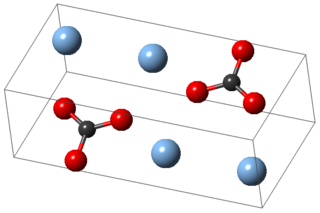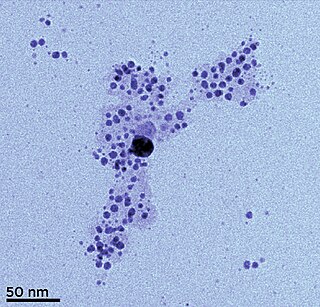
Stearic acid is a saturated fatty acid with an 18-carbon chain. The IUPAC name is octadecanoic acid. It is a soft waxy solid with the formula CH3(CH2)16CO2H. The triglyceride derived from three molecules of stearic acid is called stearin. Stearic acid is a prevalent FA in nature, found in many animal and vegetable fats, but is usually higher in animal fat than vegetable fat. It has a melting point of 69.4 °C and a pKa of 4.50.

In organic chemistry, nitro compounds are organic compounds that contain one or more nitro functional groups. The nitro group is one of the most common explosophores used globally. The nitro group is also strongly electron-withdrawing. Because of this property, C−H bonds alpha (adjacent) to the nitro group can be acidic. For similar reasons, the presence of nitro groups in aromatic compounds retards electrophilic aromatic substitution but facilitates nucleophilic aromatic substitution. Nitro groups are rarely found in nature. They are almost invariably produced by nitration reactions starting with nitric acid.

Sodium azide is an inorganic compound with the formula NaN3. This colorless salt is the gas-forming component in some car airbag systems. It is used for the preparation of other azide compounds. It is an ionic substance, is highly soluble in water, and is very acutely poisonous.

Magnesium stearate is the chemical compound with the formula Mg(C
18H
35O
2)
2. It is a soap, consisting of salt containing two equivalents of stearate (the anion of stearic acid) and one magnesium cation (Mg2+). Magnesium stearate is a white, water-insoluble powder. Its applications exploit its softness, insolubility in many solvents, and low toxicity. It is used as a release agent and as a component or lubricant in the production of pharmaceuticals and cosmetics.

Silver carbonate is the chemical compound with the formula Ag2CO3. This salt is yellow but typical samples are grayish due to the presence of elemental silver. It is poorly soluble in water, like most transition metal carbonates.

Silver nanoparticles are nanoparticles of silver of between 1 nm and 100 nm in size. While frequently described as being 'silver' some are composed of a large percentage of silver oxide due to their large ratio of surface to bulk silver atoms. Numerous shapes of nanoparticles can be constructed depending on the application at hand. Commonly used silver nanoparticles are spherical, but diamond, octagonal, and thin sheets are also common.

N-Hydroxyphthalimide is the N-hydroxy derivative of phthalimide. The compound can be utilized as a catalyst for oxidation reactions, in particular for the selective oxidation with molecular oxygen under mild conditions.

Europium compounds are compounds formed by the lanthanide metal europium (Eu). In these compounds, europium generally exhibits the +3 oxidation state, such as EuCl3, Eu(NO3)3 and Eu(CH3COO)3. Compounds with europium in the +2 oxidation state are also known. The +2 ion of europium is the most stable divalent ion of lanthanide metals in aqueous solution. Many europium compounds fluoresce under ultraviolet light due to the excitation of electrons to higher energy levels. Lipophilic europium complexes often feature acetylacetonate-like ligands, e.g., Eufod.
Cobalt compounds are chemical compounds formed by cobalt with other elements.
Tin(II) stearate is a metal-organic compound with the chemical formula C
18H
36SnO
2. The compound is classified as a metallic soap, i.e. a metal derivative of a fatty acid.
Mercury(II) stearate is a metal-organic compound, a salt of mercury and stearic acid with the chemical formula C
36H
70HgO
4. The compound is classified as a metallic soap, i.e. a metal derivative of a fatty acid. The compound is highly toxic by inhalation, ingestion, and skin absorption.

Cobalt(II) stearate is a metal-organic compound, a salt of cobalt and stearic acid with the chemical formula C
36H
70CoO
4. The compound is classified as a metallic soap, i.e. a metal derivative of a fatty acid.
Nickel(II) stearate is a metal-organic compound, a salt of nickel and stearic acid with the chemical formula C
36H
70NiO
4. The compound is classified as a metallic soap, i.e. a metal derivative of a fatty acid. The compound is harmful if swallowed and may cause skin sensitization.
Strontium stearate is a metal-organic compound, a salt of strontium and stearic acid with the chemical formula C
36H
70SrO
4. The compound is classified as a metallic soap, i.e. a metal derivative of a fatty acid.
Zirconium stearate is a metal-organic compound, a salt of zirconium and stearic acid with the chemical formula C
72H
140ZrO
8.
Cerium stearate is a metal-organic compound, a salt of cerium and stearic acid with the chemical formula C
54H
105CeO
6. The compound is classified as a metallic soap, i.e. a metal derivative of a fatty acid.
Manganese stearate is a metal-organic compound, a salt of manganese and stearic acid with the chemical formula C
36H
70MnO
4. The compound is classified as a metallic soap, i.e. a metal derivative of a fatty acid.
Lead stearate is a metal-organic compound, a salt of lead and stearic acid with the chemical formula C
36H
70PbO
4. The compound is classified as a metallic soap, i.e. a metal derivative of a fatty acid. The compound is toxic.
Caesium stearate is a metal-organic compound, a salt of caesium and stearic acid with the chemical formula C
18H
35CsO
2. The compound is classified as a metallic soap, i.e. a metal derivative of a fatty acid.
Iron(III) stearate is a metal-organic compound, a salt of iron and stearic acid with the chemical formula C
54H
105FeO
6.








